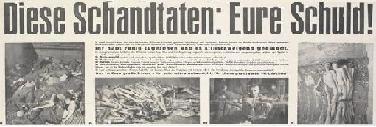


The women of defeated Germany, while already suffering enormously physically and mentally, were now subjected to an intense psychological propaganda campaign and forced to view traumatic staged exhibits of German “war crimes” as part of the “re-education” policy put in place by the Allies. Women, although not enemy soldiers, were subjected to degradation, humiliation and abuse by both Soviet and Allied occupiers, especially in German areas slated to be turned over to the communists.
During “re-education,” the foreign dead found in work camps at the end of the war were used as “learning tools” and German civilians (usually over 10 years old) were not only forced to view the dead in camps but in many cases, to bury remaining dead, even when the deaths were a result of Allied bombings or disease, sometimes at a risk to their own lives. In some cases, they were actually forced to dig up the already buried dead and rebury the corpses to “prove a point” or “teach them a lesson,” and this grisly practice took place even in typhus contaminated locations. Intentionally exposing civilians to disease is an international war crime. The soldiers supervising such operations knew of the hazards and appropriately protected themselves with masks and gloves.
April 4, 1945: Ohrdruf camp was “liberated” by US troops. On April 12th, 1945, after the citizens of Ohrdruf were forced to see the dead bodies in a macabre ceremony, the town’s Mayor and his wife returned home and purportedly killed themselves.
April 14, 1945: German civilians from Nordhausen dig mass graves for the dead prisoners from the Nordhausen work camp.
April 21, 1945: Civilians in Gardelegen are forced by the US Army 102nd Division to bury dead camp victims (see story).
April 22, 1945: U.S. troops of the 26th Infantry Division Third U.S. Army ordered local German civilians in Schwarzenfeld to exhume bodies of dead from a nearby work camp and provide coffins and a “civilized burial” for the victims.
April 29, 1945: Civilians of Neuenberg forced to dig up and rebury dead labor camps prisoners.
April 30, 1945: US soldiers of the U.S. 7th Army forced little boys “believed to be Hitler Youth” to examine boxcars at Dachau containing the dead bodies of prisoners.
May 8, 1945: Under orders of the U.S. 8th Infantry, German civilians from Schwerin attend funeral services for 80 dead prisoners from the Wöbbelin work camp. The townspeople were ordered to bury the prisoners’ corpses in the town square.
May, 1945: On orders from the U.S. Army, Austrian citizens remove corpses from the “Russian camp” section of Mauthausen for burial in a mass grave.
May, 1945: Austrian civilians are forced to dig mass graves for corpses found in Gusen.
May, 1945: German women at Belsen forced to bury dead unprotected
May 7, 1945, the 82nd Airborne Division conducted funeral services for 200 inmates in the town of Ludwigslust. German civilians from the small town are forced to file past the 200 some corpses they would have to bury at gunpoint on the palace grounds of the Archduke of Mecklenburg. Also attending the ceremony were captured German soldiers, and several hundred members of the airborne division. The U.S. Army chaplain at the service delivered a eulogy stating that:
“The crimes here committed in the name of the German people and by their acquiescence were minor compared to those to be found in concentration camps elsewhere in Germany. Here, there were no gas chambers, no crematoria; these men of Holland, Russia, Poland, Czechoslovakia, and France were simply allowed to starve to death. Within four miles of your comfortable homes, 4,000 men were forced to live like animals, deprived even of the food you would give to your dogs. In three weeks, 1,000 of these men were starved to death; 800 of them were buried in pits in the nearby woods. These 200 who lie before us in these graves were found piled four and five high in one building and lying with the sick and dying in other buildings.”
May 13, 1945: Burial of the bodies began at Dachau, over two weeks after the camp was “liberated,” and by then some of the bodies were so rotten they were literally falling apart. It should be noted that the inmates at Dachau continued to die of typhus for weeks after the camp was “liberated.” The bodies had been left out in the open to photograph and to show US GIs. When there was no more use for the corpses, the Americans forced women of Dachau to disinfect the boxcars of the death train and the local farmers to haul the corpses to Leitenberg hill near the camp where they were buried in mass graves. The US Army demanded that the farmers “dress up” and parade their wagons through the town of Dachau to humiliate them. After Dachau was liberated, the camp was turned into a prison for German soldiers and then used to house eastern German refugees who were driven from their homes.
May 17-19, 1945: In Namering, 800 work camp prisoners died during evacuation and were buried in a mass grave by German soldiers. American soldiers forced the people in the town to dig up the three week old corpses and bury them in individual graves after they laid in the open for five more days.
Events such as the supposed “Massacre at Gardelegen” were exploited to punish German civilians:
In 1945, as Allied troops penetrated Germany, prisoners from work camps in outlying areas were evacuated and sent to the interior of the Reich, at times by foot since the rail lines were destroyed by bombing. By this point, many were malnourished and weak from typhus. Some 4,000 prisoners from distant camps arrived in the Gardelegen area and according to witnesses, over a thousand of them soon died and their bodies were burned in a large barn. However, one man supposedly told the US Army he “witnessed them being burned alive.” The U.S. Army Signal Corps liked his version and photographers arrived to “document the crime.” By April 19, 1945, the story of the “Gardelegen Massacre” dutifully and sensationally appeared in the New York Times and the Washington Post.
On April 21, 1945, the local US Army commander of the 102nd Division ordered between 200 and 300 civilians from the nearby town of Gardelegen, mostly old or very young men, to exhumed 1,016 dead bodies and bury them each in an individual grave. On April 25, the US Army carried out a dramatic and photographed ceremony to “honor the dead” and they erected a memorial tablet demanding that the townspeople of Gardelegen forever keep the graves green “as the memory of these unfortunates will be kept in the hearts of freedom-loving men everywhere.” On that day, Colonel George Lynch addressed German civilians at Gardelegen (who had nothing at all to do with the deaths) with the following statement:
“The German people have been told that stories of German atrocites were Allied propaganda. Here, you can see for yourself. Some will say that the Nazis were responsible for this crime. Others will point to the Gestapo. The responsibility rests with neither – it is the responsibility of the German people.... Your so-called Master Race has demonstrated that it is master only of crime, cruelty and sadism, you have lost the respect of the civilized world.”
The process was especially cruel for female German military personnel who, at the insistence of the Allies, were labelled “disarmed enemy forces” (DEF) rather that “prisoners of war” and as such were not afforded protection from the Hague Land Warfare Convention which mandated humane treatment of prisoners. Many such women were merely clerical workers and office personnel, yet this slip in semantics offered their captors the freedom to degrade and abuse them at will.
On April 15, 1945, the Belsen prison camp was occupied by British troops who found thousands of decaying corpses scattered about the grounds. In the final, chaotic months of the war, trains had brought to Belsen thousands of new inmates from other camps in the east which had experienced catastrophic conditions during the final months of the war when food and medical transports were being destroyed on the roads and railways by Allied bombers. This made the conditions at Belsen even worse, and the ensuing shortage of food, water and medicines together with overcrowding and an uncontrollable outbreak of typhus had caused the deaths of thousands of inmates.
A few weeks after the British takeover, another 13,000 died, some 2,000 of them after eating the rich food given to them by the British. On May 2, some 95 medical students from London’s teaching hospitals were flown to Belsen to help treat the sick prisoners. It was acknowledged that there was no deliberate intention by the Germans to starve the prisoners to death at Belsen. There were no gas chambers and the “crematorium” consisted of only one furnace in which to dispose of the dead.
All the same, the British executed the camp’s commandant and his chief physician at the ‘Belsen War Crimes Trial’ in spite of valiant efforts they had made to remedy the horrible situation. They had quarantined the camp and done everything in their power to prevent the catastrophe, even begging the surrounding population to donate vegetables and food. Of a total of 86 staff members captured at Belsen, 28 were women, most in clerical positions. By June 17, at least twenty had died, most from digging graves to bury the dead inmates which the British forced them to do. By the end of the month the whole camp had to be burned down.

|
| 1. Top: Female civilians being forced, without protective gloves or masks, to view dead bodies under the watchful, paternal eyes of male Allied soldiers, a process which amounted to a public spanking. Bottom: US Dept of Defense photo of Civilians in Nordhausen forced to rebury the camp dead without the masks, glove or protective gear which the GIs present are wearing (Nordhausen was destroyed in one 15 minute bombing attack that killed 20% of its civilian population and then occupied by the US just long enough to “reeducated” the citizens before handing it over to the communists and slavery). |

|
| 2. Civilians forced to bury dead in Gardelegen, Ohrdruf and Gusen. |

|
| 3. Civilians being forced to bury or handle the dead at Dachau, Mauthausen, Namering and children in Dachau forced to view corpses. |
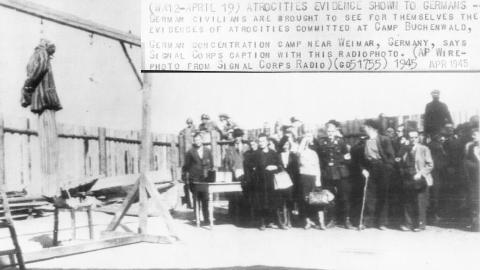
|
| 4. Civilians forced to watch staged “atrocity” exhibits in Weimar. |
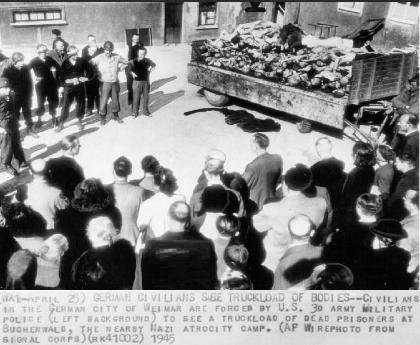
|
| 5. More civilians forced to watch staged “atrocity” exhibits in Weimar. |
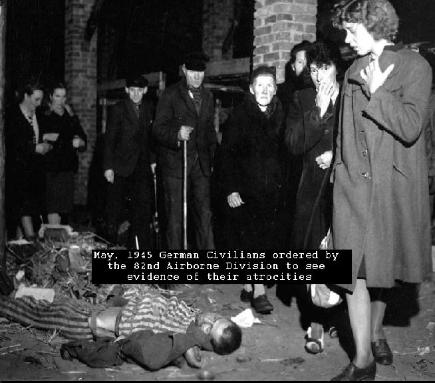
|
| 6. Women being forced to view another exhibit. |
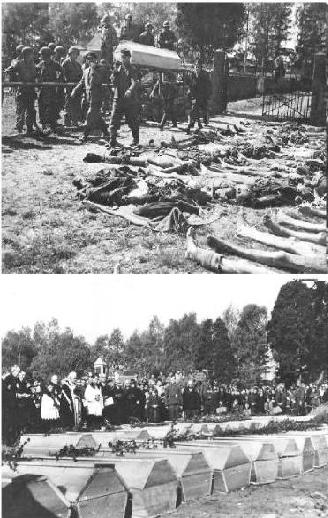
|
| 7. German civilians in Schwarzenfeld carry a casket containing a body past rows of other victims awaiting burial; forced to dig graves for the victims under U.S. Army supervision; 500 German civilians forced to attend burial services for the victims. (U.S. Signal Corps Photos). |
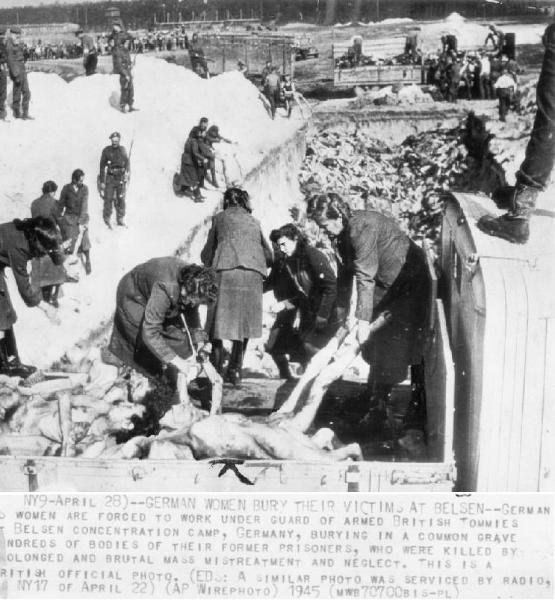
|
| 8. Women at Belsen forced to dig graves and bury dead (story above). |
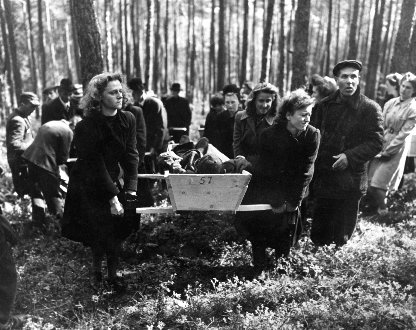
|
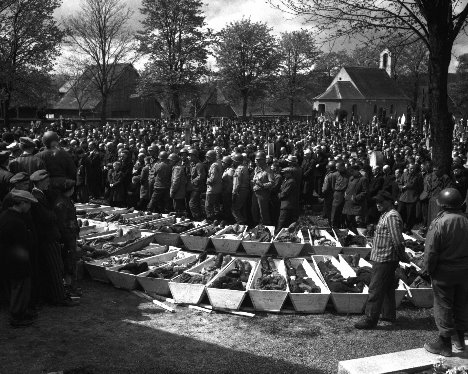
|
| 9. (2 photos) Civilians of Neunburg forced to exhume and bury bodies from nearby work camp by U.S. Third Army; U.S. Third Army conducting a forced civilian burial service for the dead of war. |

|
| 10. Civilians of Namering re-bury 800 three-week-old corpses after they had laid in the open for 5 more days. |